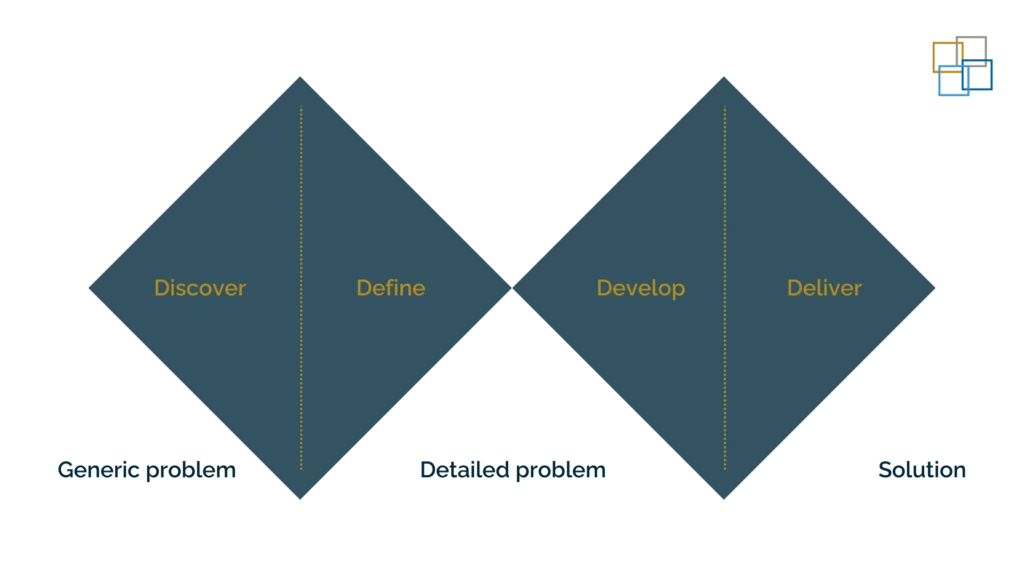
The Design Sprint process was created by Jake Knapp at Google in 2010. A sprint is a time-limited process (between 5 and 10 days) to find solutions to questions of design, prototyping, and testing ideas with customers. Google Ventures went so far as to suggest that using a design sprint is like having a superpower.
The five typical steps in a sprint are:
- Understand
- Diverge
- Decide
- Prototype
- Validate
The first question is why you need a design sprint for your new product, service or feature. The answer is that when using agile methodology or another iterative delivery model you grow the solution as the project progresses. You start with nothing and solve a piece of the puzzle with each iteration.
You need to consider what the end goal is yet avoid spending too much time over-analysing or over-architecting by writing code with unneeded and unused features. Of course, you can simply use trial-and-error, experimenting and building prototypes through several sprints and iterations, but that would cost you time and money and more importantly, how could you be confident that you will deliver what your customer wants? Design sprints offer answers to these questions and give you a clear direction at the start of each major task that requires you to focus either on the client or the user experience.
There are various tools and methods available to help you achieve a design sprint and one of them is the widely respected Double Diamond process.
Double Diamond Sprint
Almost twenty years ago, in 2003, the British Design Council introduced the innovative Double Diamond design sprint process. Kite-shaped models had existed for decades but were not widely referenced.
The Double Diamond process consists of two cycles that follow a pattern of ‘expand and converge’. Each cycle is represented by a diamond, one focusing on the problem and the other on the solution. You are asked to think first of the broader issue, then hone-in on the problem you are trying to solve and focus on a solution to that single challenge.
The first Diamond represents the phase when you ask your team to identify the problem by gathering insights and data. This is when you achieve a complete understanding of the user’s perspective and problems. Only once you have identified, and agreed, a definition of the problem can you move on to the next stage of the process.

In the second Diamond your team will focus on potential solutions. These are discussed, and the next iteration is produced. This process is repeated until there is an agreed overall solution. It is essential that all members of the team contribute, and their feedback is considered. Encouraging team members to think outside-the-box should result in a solution that incorporates a wide range of ideas and interests.
Choosing your team for a Double Diamond Sprint
You want the number of participants to be large enough to voice all the insights you need to define the problem, but small enough to be able to focus on the task. From experience we at Projective Group recommend a team size / number of participants between 6 and 8 people. These should include at least a key decision maker, product manager, customer expert, design expert, technical specialist and marketing expert all led by a strong group facilitator. The input from experts at the start of every design sprint is essential.
Tools and techniques to use in a Double Diamond approach
A Press Release announcing the project underlining the strategic vision and encouraging questions is a great way to launch a Double Diamond sprint. It also helps to make sure that everyone feels included in the process.
In fact, the views and feedback of users are essential to the success of any design sprint. Invite them to contribute their thoughts and then follow up these comments with structured interviews. Perhaps, take the time to watch them at work to better understand, and empathise with, their needs. Make sure that the results of the interviews are used to reshape your initial understanding of the issues to be resolved. This all contributes to building better, stronger, client relationships which will make for better feedback during testing and delivery. The same techniques can be used for the conceptual UX design and mock-up stage as well as for the testing of prototypes.
When it comes to the actual process, nothing feels more welcoming to the design team than to find themselves surrounded by newly sharpened pencils, blank paper, flipcharts, Blu-Tack and Post-Its ready for them to translate their ideas into tangible solutions. Of course, it is possible to work completely online, to have a fully virtual format, but that requires additional tooling and software.
There is no time for hiding under rocks during this process! Every team member must contribute. The design sprint is an intense process and results from each stage are fed back into the process to form the foundations for the next stage.
The key benefits of the Double Diamond design process
The benefits are many, but these are some of the key points you may like to consider.
Time: the design sprint is a time constrained process that produces rapid results and takes into account the customer’s point of view. A design sprint allows early feedback on rough prototypes which saves time, as no longer do you have to wait until you reach the delivery cycle to be able to make these comments.
Vision: The design sprint is a great tool to create a common baseline of understanding and direction before the delivery cycle starts.
Strategic: A diverse team structure should result in strong and broad commitment to the overall solution.
Collaborative: A design sprint needs a broad set of skills and areas to which all can contribute and from which they can learn.
Visual: Everything developed during the design sprint can be reviewed as drawings, mock-ups and prototypes. This should lead to a high level of understanding of, and interaction with, the model.
Tested: Results are qualified and customer feedback can be directly incorporated into the design.
How Projective Group can support you
If you are currently reviewing the option of a new product, service or feature and would like to learn more about a quick and easy method to successfully implement and run a design sprint, Projective Group can help you.
Leveraging the right tools understanding the relevant processes and working in a tailored agile environment are some of our core competencies.
Reach out to one of our experts or leave us a message if you’d like to have more info. We’re always up for a chat.
About Projective Group
Established in 2006, Projective Group is a leading Financial Services change specialist. With deep expertise across practices in Data, Payments, Transformation and Risk & Compliance.
We are recognised within the industry as a complete solutions provider, partnering with clients in Financial Services to provide resolutions that are both holistic and pragmatic. We have evolved to become a trusted partner for companies that want to thrive and prosper in an ever-changing Financial Services landscape.



